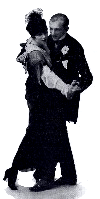|
Banjo and Sidecar are considered to be forms of Closed
position, in that hips are together, bodies are facing, and each is
looking out his or her respecitve window, but the bodies are turned
just a little so that the man steps outside his partner's feet and not
between her feet. In Banjo, he steps outside to her right, and in
Sidecar, he steps outside to her left.
In the photo above left, notice how the woman's head is
closed. The man has clear left side lead, and his next step will
clearly be outside his partner's right foot. His thighs will be crossed
in a good contra position when he takes that step.
Their bodies are not progressing squarely in the
direction of movement but are "slicing," bodies oriented diagonally to
the line of progression. Swing the left side down line, and the man
will cross his thighs and step outside into Banjo. Swing the right side
down line, and he will step between her feet, back into Closed again.
If the man leads still more strongly with his right
side, then he will cross his left thigh in front of the right and step
outside his partner to her left, in Sidecar position. In the second
photo at right, notice how the bodies are facing, and she is still
positioned to his right (in Closed position). She is looking strongly
left (closed head), and he is looking a bit to her right, out his
window, but his right-side lead is strong, his left leg is crossed in
front of his right, and he is stepping forward with his left foot to
the outside of her left foot.
Banjo position is used more often than Sidecar, and the
following photos are all of Banjo.
|
Contra-Banjo—

Contra-Sidecar—

|
| In a side view, we can see just how square each is to
the other, right hip to right, just as in closed position. We can't see
his right foot, but we can see that it is not between her feet; he is
stepping outside to her right. |

(click on any thumbnail for a larger view)
|
Here is a photo taken from
Gotta Ballroom by Christine Zona & Chris George, 2008, showing banjo on the left and
sidecar on the right. Note the shoulder lead, the crossed thighs, and the "overlap" in their
bodies. They are not hip-to-hip but in an only slightly modified closed
position. Particularly in sidecar, the man is still looking out his
"window." He may be ready to step outside partner on her left, but he
is still thinking about his proper dance position on her right.
|

|

